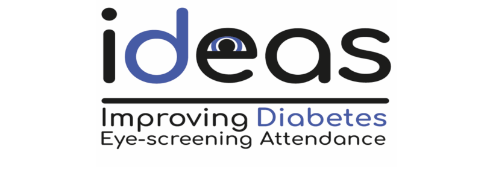- PPI Case Studies
- PPI Resources
- Introduction to PPI
- Difference between PPI and qualitative research
- Involving children and young people in research
- PPI and doctoral research
- PPI in systematic reviews
- PPI in qualitative analysis
- Reporting PPI
- PPI in funding applications
- Budgeting for PPI
- PPI and lab-based research
- Evaluating PPI
- Events and Seminars
- 2024 Summer Student Scholarships
- News and Events
- About Us
- PPI Seed Funding Scheme 2023
- PPI Shared Learning Group for PhD Researchers
- PPI Ignite Network@ UCC Mailing List
- Digital Badge
The IDEAs study

Brief overview of the project
This project was led by Dr Sheena McHugh, School of Public Health, UCC and aimed to develop and test an intervention to improve uptake of the national diabetic retinopathy screening programme, Diabetic RetinaScreen. The intervention was developed using a staged process: interviewing people with diabetes and health professionals to identify determinants of uptake, mapping these to behaviour change techniques to develop intervention content, before conducting a consensus process with users of the intervention (people with diabetes and health care professionals) to elicit their views on the feasibility, acceptability, and local relevance of the proposed content. The intervention was evaluated through a pilot cluster randomised controlled trial with a wait-list control group, embedded process evaluation and a partial economic evaluation (cost analysis) over a 12-month period [July 2019-July 2020].
Description of Public and Patient Involvement (PPI) in this project
A Patient and Public Involvement group were involved throughout the project both during intervention development and the pilot trial. They advised on the development of the intervention materials, the format and language of study materials (i.e., patient recruitment materials, information leaflets and consent forms) and our dissemination approach.
Who is/was involved?
Five people with diabetes; three women and two men were part of the PPI panel.
Challenges and/or solutions
We learned from the recruitment approach. We had a joint recruitment drive to find people to take part in the consensus process and the PPI panel which we felt made it easier to find people. There was generally interest in both aspects of the project. There was some trial and error with recruitment. For example, we tried posting information in waiting rooms in general practices and a hospital diabetes clinic but did not see any uptake via those avenues. We had more successful recruitment through attending structured education and support groups where we could explain the study in person, and also via social media through a gatekeeper (someone active on social media and online diabetes groups). We had a graphic designer develop our recruitment flyer which we felt made it more engaging. We also put our photos on the flyer– while we do not know whether this made a difference hopefully it meant the team seemed more approachable!
We had a dedicated PPI coordinator to manage the panel, and arrangement we felt worked really well and made organising the project much easier. The PPI coordinator was able to build rapport with the panel and act as their ‘voice’ within the main research team. The panel would meet at a time and place that suited them, the meeting would be facilitated by the PPI coordinator, who would then collate their feedback and bring that back to our team. It could potentially be challenging if different members of the research team were to attend different meetings, having one person in that role seems a better approach.
One challenge we did not have a definite solution to, other than through discussion within the research team, was how to weight the feedback from the PPI panel. This was particularly the case with an information leaflet we developed as part of the intervention; we were getting feedback from other stakeholders within the study (e.g., health care professionals, project advisory group), and it was sometimes difficult to marry the different suggestions, often those around wording.
What difference did public involvement make?
The difference their input made was particularly clear in terms of an information leaflet we developed as part of the intervention. We had decided the content of the leaflet with the input of health care professionals and people with diabetes. We knew broadly which key messages we wanted to include and how the intervention was to be delivered. However, a lot of work went into designing the leaflet, namely, the wording, format, and layout. The PPI group were a crucial part of that design process. They had valuable suggestions which ranged from advice on the language (e.g., avoiding the use of the word ‘retinopathy’) to coming up with new ideas about how to communicate certain messages (e.g., suggesting we emphasise the friendliness of the screening programme and how accommodating they were should people need to change their appointment – something they had personally experienced).
What would you advise researchers about involvement?
Think about recruitment avenues early. It helps to establish a larger panel from which people can be invited. It might be good idea for teams to talk about how they plan to bring in feedback from the PPI panel and weigh it against other feedback from different stakeholders across the project, for example, agreeing who has the final word on changes to different materials, and how differences of opinion on language for example, might be handled.
More information
The IDEAs PPI group were involved in developing the LIVE (LIstening to the Voice of Experience) podcast. In the following episode, IDEAs PPI group members talk about how they are using their experiences of diabetes to inform and shape the research being conducted.
Contact information and related links
